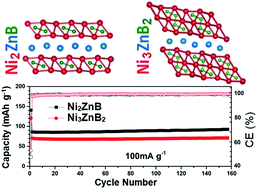Ternary MAB phases (layered transition metal borides) have recently attracted interest due to their exfoliation potential toward MBenes (analogous to MXenes), which are predicted to have excellent Li-ion battery performance. We have achieved single-phase synthesis of two MAB phases with general composition Nin+1ZnBn (n = 1, 2), the crystal structures of which contain zinc layers sandwiched between thin (n = 1) and thick (n = 2) Ni–B slabs. Highly stacked MAB sheets were confirmed by X-ray diffraction and high-resolution scanning electron microscopy for both materials. Exposing Nin+1ZnBn to diluted hydrochloric acid led to the creation of crystalline microporous structures for n = 1 and non-porous detached sheets for n = 2. Both morphologies transformed the inactive bulk materials into highly active Li-ion battery anodes with capacities of ∼90 mA h g−1 (n = 1) and ∼70 mA h g−1 (n = 2) at a 100 mA g−1 lithiation–delithiation rate. The XPS analysis and BET surface area measurements reveal that the increased surface area and the reversible redox reaction of oxidized nickel species are responsible for this drastic increase of the lithiation–delithiation capacity. This proof of concept opens new avenues for the development of porous MAB, MAB nanosheets, MBenes and their composites for metal-ion battery applications.

